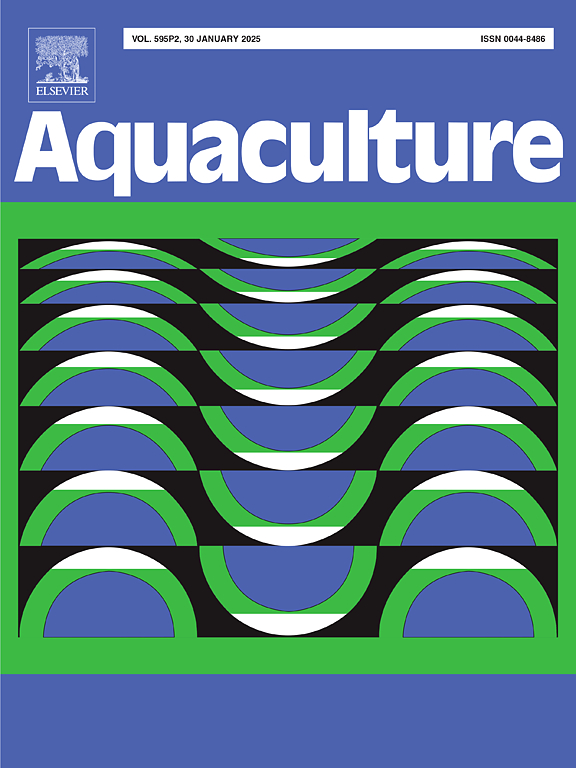Comparative study on the role of various sterols in enhancing ovarian development and metabolic functions in Pacific white shrimp (Litopenaeus vannamei) broodstock
IF 3.9
1区 农林科学
Q1 FISHERIES
引用次数: 0
Abstract
In this study, the Pacific white shrimp (Litopenaeus vannamei) broodstock was considered to rely on dietary sterols for ovarian development because of the inability of the animals to synthesize sterols endogenously. Therefore, we investigated the effects of cholesterol, ergosterol, β-sitosterol, and fucosterol as sterol sources, compared with a control group lacking sterols, on the growth, reproduction, and metabolism of shrimp for a 28-day feeding trial, with an average weight of 32.28 ± 2.00 g in female L. vannamei broodstock. The results demonstrated that cholesterol supplementation significantly enhanced shrimp growth, the gonadosomatic index, and yolk particle deposition, outperforming the other sterol groups and the control group. Notably, while broodstock in the ergosterol group presented the greatest weight gain and yolk granule deposition, they did not achieve the same level of gonadal development or metabolic efficiency as those receiving cholesterol. Additionally, the β-sitosterol group demonstrated a favorable hepatosomatic index but still fell short of the benefits provided by cholesterol. Cholesterol has unique advantages in promoting growth and ovarian development, which may be attributed to its more efficient metabolic utilization and enhanced hormone synthesis, as indicated by the significantly higher serum levels of 17β-estradiol and progesterone in the cholesterol group. Furthermore, cholesterol supplementation significantly upregulated vitellogenin mRNA expression in the hepatopancreas and ovaries, thereby promoting ovarian maturation. Additionally, γ-linolenic acid and 9,10-epoxyoctadecenoic acid were significantly upregulated in the cholesterol group, facilitating ovarian lipid accumulation. In conclusion, the use of cholesterol as a sterol source in the diet significantly promoted the growth and ovarian development of L. vannamei by regulating lipid metabolism and hormone synthesis.
关于各种甾醇在促进太平洋南美白对虾(Litopenaeus vannamei)育苗卵巢发育和代谢功能方面作用的比较研究
在本研究中,由于太平洋南美白对虾(Litopenaeus vannamei)种群无法内源合成固醇,因此其卵巢发育依赖于膳食固醇。因此,我们研究了胆固醇、麦角甾醇、β-谷甾醇和褐藻甾醇作为甾醇来源,与缺乏甾醇的对照组相比,对虾的生长、繁殖和新陈代谢的影响,喂养试验为期 28 天,雌性凡纳滨对虾育苗的平均体重为 32.28 ± 2.00 克。结果表明,补充胆固醇可显著提高对虾的生长、性腺指数和卵黄颗粒沉积,其效果优于其他固醇组和对照组。值得注意的是,虽然麦角甾醇组的对虾体重增加最多,卵黄颗粒沉积也最多,但它们的性腺发育和代谢效率却不如胆固醇组。此外,β-谷甾醇组显示出良好的肝功能指数,但仍无法达到胆固醇带来的益处。胆固醇在促进生长和卵巢发育方面具有独特的优势,这可能是由于胆固醇的代谢利用效率更高,激素合成能力更强,胆固醇组的血清中 17β-雌二醇和孕酮水平明显更高。此外,补充胆固醇还能明显提高肝胰腺和卵巢中卵黄素 mRNA 的表达,从而促进卵巢成熟。此外,胆固醇组中的γ-亚麻酸和9,10-环氧十八烯酸的表达也明显增加,从而促进了卵巢脂质的积累。总之,通过调节脂质代谢和激素合成,在日粮中使用胆固醇作为固醇源可明显促进凡纳滨鲤的生长和卵巢发育。
本文章由计算机程序翻译,如有差异,请以英文原文为准。
求助全文
约1分钟内获得全文
求助全文
来源期刊

Aquaculture
农林科学-海洋与淡水生物学
CiteScore
8.60
自引率
17.80%
发文量
1246
审稿时长
56 days
期刊介绍:
Aquaculture is an international journal for the exploration, improvement and management of all freshwater and marine food resources. It publishes novel and innovative research of world-wide interest on farming of aquatic organisms, which includes finfish, mollusks, crustaceans and aquatic plants for human consumption. Research on ornamentals is not a focus of the Journal. Aquaculture only publishes papers with a clear relevance to improving aquaculture practices or a potential application.
 求助内容:
求助内容: 应助结果提醒方式:
应助结果提醒方式:


